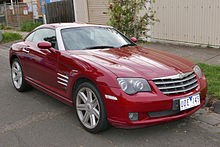The Chrysler Crossfire Car, a vehicle born from an intriguing collaboration with Mercedes-Benz, occupies a peculiar space in automotive history. Effectively built upon the bones of the Mercedes-Benz R170 SLK, the Crossfire aimed to inject Chrysler’s bold styling into a proven German platform. However, despite its unique aesthetics and underlying engineering, the Crossfire faced a barrage of negative reviews and ultimately became a commercial disappointment.
 Chrysler Crossfire Coupe parked, showcasing its distinctive rear styling and overall design.
Chrysler Crossfire Coupe parked, showcasing its distinctive rear styling and overall design.
Critical Reception: A Barrage of Negativity
The Chrysler Crossfire car was met with harsh criticism from prominent automotive journalists. Jeremy Clarkson, during a Top Gear episode in 2003, famously lambasted the car. He found fault with almost every aspect, citing “poor handling,” a “cheap interior,” and deficient “road feel.” Clarkson went as far as to suggest that potential buyers would be better off purchasing a used Mercedes R170 instead. His most memorable critique centered on the Crossfire’s styling, particularly the rear end, which he unflatteringly compared to a dog defecating.
Top Gear magazine echoed Clarkson’s sentiments, including the Crossfire car in their list of “The 13 Worst Cars of the Past 20 Years.” They described it as a concept that failed in execution, labeling it “outdated before it was even launched” due to its first-generation Mercedes SLK underpinnings. The magazine concluded it was “the ultimate triumph of style over content, only without the style. Or much content.”
Stephen Bailey of The Daily Telegraph delivered an equally scathing review in 2004, declaring the Crossfire “indubitably the worst car I have ever driven.” He expressed disbelief that Mercedes-Benz, “the aristocrats of engineering,” would associate themselves with such an “aesthetic, functional and social atrocity.”
Adding to the chorus of disapproval, Car and Driver listed the Crossfire car among the worst car flops of the past 25 years. They attributed its failure to “overwrought styling” combined with “rehashed, last-generation Mercedes-Benz chassis components.” The publication noted that the art-deco design and premium price tag deterred buyers, many of whom opted for alternatives like the Mercedes SLK, Infiniti G35, or BMW 3-series, cars deemed more enjoyable to drive and less visually polarizing. Car and Driver also reiterated the unflattering dog defecating comparison regarding its rear styling.
Edmunds.com further solidified the Crossfire’s negative reputation by naming it one of the top automotive failures of the last decade. They pointed to “antiquated recirculating-ball steering,” “disappointing handling,” and a “harsh ride” as key dynamic flaws. The interior and overall performance also fell short of expectations. Edmunds.com highlighted the ultimate humiliation of unsold Crossfires being liquidated on Overstock.com and eBay, even suggesting that not even celebrity endorsement from Celine Dion could salvage its image. AOL UK went as far as to name the Chrysler Crossfire car the worst car of the 2000s decade.
A User’s Counterpoint: Appreciation Amidst Frustrations
Despite the overwhelming negativity from professional critics, some owners and enthusiasts hold a different perspective on the Chrysler Crossfire car. One user, expressing their opinion in an online forum, vehemently disagreed with the critical consensus. They found the handling to be “great” and expressed fascination with the car’s concept and manufacturing. Acknowledging its sports car nature and two-seat configuration, they conceded its market appeal would naturally be limited compared to mass-market vehicles.
However, this user pinpointed a significant issue: Chrysler’s policy regarding service and spare parts. They described it as “outrageous,” citing “ridiculous amounts for service and parts,” even for used components. As a stark example, they mentioned headlight covers, stating that a single used piece could cost over $400, while a new set of two headlight covers for other brands could be obtained for around $100. This user’s experience highlights a crucial aspect of Crossfire ownership – the potential for exorbitant maintenance and repair costs.
The Ownership Experience: A Mixed Bag
The Chrysler Crossfire car presents a dichotomy. Its striking design, albeit controversial, and Mercedes-Benz underpinnings offer a unique blend of style and engineering. While critics panned its driving dynamics and aesthetic choices, some owners find enjoyment in its distinctive character. However, the shadow of negative reviews and the very real concern of expensive parts and service cast a long shadow over the Crossfire’s appeal. For those considering a used Chrysler Crossfire car, it’s crucial to weigh the potential for a stylish and somewhat exclusive sports car against the documented criticisms and the potential financial burden of maintaining a vehicle with a reputation for costly parts and service. The online communities surrounding the Crossfire, as the user noted, can offer valuable support and information for navigating these ownership challenges.
